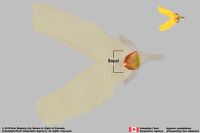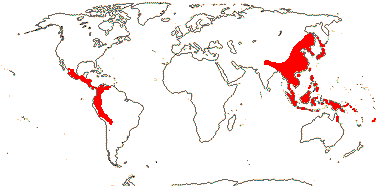Family Name: Actinidiaceae Gilg & Werderm.
Synonym(s): Saurauiaceae Griseb., nom. cons.
Common Name(s): Chinese-gooseberry family
*Number of genera/species: 3/360
List of genera records in GRIN-Global
Fruit usually a berryberry:
an indehiscent, fleshy fruit with one or a few to many seeds. The flesh may be homogenous throughout. Or, if the outer part is hard, firm, or leathery, referred to as an hesperidium. Septa are present in some, and the seeds may be arillate or with a fleshy testa. , sometimes a loculicidal capsule, 3–60 mm (cultivated fruits larger), globoseglobose:
, sometimes a loculicidal capsule, 3–60 mm (cultivated fruits larger), globoseglobose:
3D shape—more or less spherical to cylindricalcylindrical:
to cylindricalcylindrical:
3D shape—a cylinder, with parallel sides and a circular cross-section; tubular or rod-shaped
, tereteterete:
approximately circular in cross section; width and thickness approximately equal
 in transection, sometimes beakedbeak:
in transection, sometimes beakedbeak:
a usually firm, terminal appendage, sometimes tapered , with numerous seeds (up to 1,500 in Actinidia), reflexed sepalssepal:
, with numerous seeds (up to 1,500 in Actinidia), reflexed sepalssepal:
a member of the outer envelope of a flower (calyx) sometimes persistent. Pericarppericarp:
sometimes persistent. Pericarppericarp:
fruit wall or fruit coat
variable, fleshy (berryberry:
an indehiscent, fleshy fruit with one or a few to many seeds. The flesh may be homogenous throughout. Or, if the outer part is hard, firm, or leathery, referred to as an hesperidium. Septa are present in some, and the seeds may be arillate or with a fleshy testa. ) or leatheryleathery:
) or leatheryleathery:
texture—moderately thick, tough, and very pliable
(capsulecapsule:
a dry, dehiscent fruit derived from a compound ovary ), glabrousglabrous:
), glabrousglabrous:
without hairs
or pubescentpubescent:
surface relief—bearing hairs
, smooth, ribbedribbed:
surface relief—wide, prominent, linear ridges that are generally rounded and longitudinally situated on the surface , or lenticulate. BerriesBerry:
, or lenticulate. BerriesBerry:
an indehiscent, fleshy fruit with one or a few to many seeds. The flesh may be homogenous throughout. Or, if the outer part is hard, firm, or leathery, referred to as an hesperidium. Septa are present in some, and the seeds may be arillate or with a fleshy testa. with massive placentae. Seeds usually embedded in mucilaginousmucilaginous:
with massive placentae. Seeds usually embedded in mucilaginousmucilaginous:
resembling mucilage; moist and sticky
, greenish pulp.
Seeds oblongoblong:
2D shape—much longer than broad with nearly parallel sides, corners are rounded or trigonoustrigonous:
or trigonoustrigonous:
3D shape—having three faces that meet at distinct angles; triangular in outline
, tereteterete:
approximately circular in cross section; width and thickness approximately equal
 in transection, 0.7–2.5 mm. Sarcotestasarcotesta:
in transection, 0.7–2.5 mm. Sarcotestasarcotesta:
pulpy or fleshy outer layer of the seed coat, simulates aril present, fleshy. Seed coat brown, thin, crustaceouscrustaceous:
present, fleshy. Seed coat brown, thin, crustaceouscrustaceous:
texture—thin, dry, indurate, and brittle
, sometimes cartilaginouscartilaginous:
texture—firm, dense, tough, somewhat pliable, and resilient, like cartilage
, reticulatereticulate:
surface relief—netted, raised walls or concave grooves forming a net-like surface pattern with flat, concave, or convex interspaces or areolate.
or areolate.
Embryo well developed, nearly filling seed cavity, axileaxile:
on or of the axis
and centric, linearlinear:
(shape) long, narrow, and uniform in width; (of embryo) embryo is straight and much longer than wide , straight or slightly curvedcurved:
, straight or slightly curvedcurved:
(of embryo) linear embryo is curved into an arch or horseshoe with the ends far apart , with massive, flat cotyledons.
, with massive, flat cotyledons.
Endosperm copious, fleshy-firm (Actinidia, Clematoclethra) and mealymealy:
loose, dry, and disintegrating in finely granular
pieces like meal or flour
(Saurauia).
| Fruit | |
| Type | usually berryberry: an indehiscent, fleshy fruit with one or a few to many seeds. The flesh may be homogenous throughout. Or, if the outer part is hard, firm, or leathery, referred to as an hesperidium. Septa are present in some, and the seeds may be arillate or with a fleshy testa.  , rarely loculicidalloculicidal: , rarely loculicidalloculicidal:type of capsular dehiscence, opening longitudinally through the locules (compare septicidal)  capsulecapsule: capsulecapsule:a dry, dehiscent fruit derived from a compound ovary  |
| Size range | 3–30 mm long, to 150 mm in cultivated fruits |
| Shape(s) | globoseglobose: 3D shape—more or less spherical  , depressed-globose, oblongoblong: , depressed-globose, oblongoblong:2D shape—much longer than broad with nearly parallel sides, corners are rounded  , cylindricalcylindrical: , cylindricalcylindrical:3D shape—a cylinder, with parallel sides and a circular cross-section; tubular or rod-shaped , mammilliform |
| Texture | usually fleshy, rarely leatheryleathery: texture—moderately thick, tough, and very pliable (capsulecapsule: a dry, dehiscent fruit derived from a compound ovary  ) ) |
| Surface relief | smooth, ribbedribbed: surface relief—wide, prominent, linear ridges that are generally rounded and longitudinally situated on the surface  , lenticellate, often pubescentpubescent: , lenticellate, often pubescentpubescent:surface relief—bearing hairs |
| Color(s) | brown, black, blackish green, purple, red, yellow, orange, red, green, white |
| Unique features | Usually large dark to bright colored berriesberry: an indehiscent, fleshy fruit with one or a few to many seeds. The flesh may be homogenous throughout. Or, if the outer part is hard, firm, or leathery, referred to as an hesperidium. Septa are present in some, and the seeds may be arillate or with a fleshy testa.  with seeds enclosed in mucilaginousmucilaginous: with seeds enclosed in mucilaginousmucilaginous:resembling mucilage; moist and sticky , greenish or yellowish pulp. Pulp often sweet and edible. |
| Seed | |
| Size range | 0.7–2.5 mm long |
| Shape(s) | oblongoblong: 2D shape—much longer than broad with nearly parallel sides, corners are rounded  , trigonoustrigonous: , trigonoustrigonous:3D shape—having three faces that meet at distinct angles; triangular in outline |
| Surface relief | reticulatereticulate: surface relief—netted, raised walls or concave grooves forming a net-like surface pattern with flat, concave, or convex interspaces  , areolate , areolate |
| Color(s) | brown |
| Unique features | Brown, often shinyshiny: uniformly reflecting a high proportion of incident light at all angles  , reticulatereticulate: , reticulatereticulate:surface relief—netted, raised walls or concave grooves forming a net-like surface pattern with flat, concave, or convex interspaces  or areolate seeds with large embryos and copious endosperm. or areolate seeds with large embryos and copious endosperm. |
| Other | |
| Embryo | well developed, nearly filling seed cavity, linearlinear: (shape) long, narrow, and uniform in width; (of embryo) embryo is straight and much longer than wide  , straight or slightly curvedcurved: , straight or slightly curvedcurved:(of embryo) linear embryo is curved into an arch or horseshoe with the ends far apart  , with massive, flat cotyledons , with massive, flat cotyledons |
| Nutritive tissue | endosperm copious |
Temperate to subtropical regions of Southeast Asia and Malesian. Saurauia also occurs in Central and South America and a single species in Australia

Distribution map courtesy of Angiosperm Phylogeny Website.
Kirkbride et al. 2006Kirkbride et al. 2006:
Kirkbride JH, Jr, Gunn CR, and Dallwitz MJ. 2006. Family guide for fruits and seeds, vers. 1.0. Accessed September 2020-January 2022. URL: https://nt.ars-grin.gov/seedsfruits/keys/frsdfam/index.cfm .; Kubitzki et al. 1990+Kubitzki et al. 1990+:
Kubitzki K et al., eds. 1990+. The families and genera of vascular plants. 7+ vols. Berlin etc.; Takhtajan 2009Takhtajan 2009:
Takhtajan A. 2009. Flowering plants: Second edition. Springer Nature, Switzerland. 871 pp.; Utteridge and Jennings 2022Utteridge and Jennings 2022:
Utteridge TMA and Jennings LSA. 2022. Trees of New Guinea. Kew Publishing, Royal Botanic Gardens, Kew. 656 pp.; Zhengyi et al. 2004+Zhengyi et al. 2004+:
Zhengyi W, Raven PH, and Deyuan H. 2004+. Flora of China [online]. 25 vols. Science Press, Beijing China & Missouri Botanical Garden, St. Louis USA. Accessed January–March 2024. http://flora.huh.harvard.edu/china/
*The number of genera and species is based on Christenhusz and Byng 2016Christenhusz and Byng 2016:
Christenhusz MJM and Byng JW. 2016. The number of known plant species in the world and its annual increase. Phytotaxa 261 (3): 201-217. https://doi.org/10.11646/phytotaxa.261.3.1, which may differ from the number of genera in GRIN-Global.